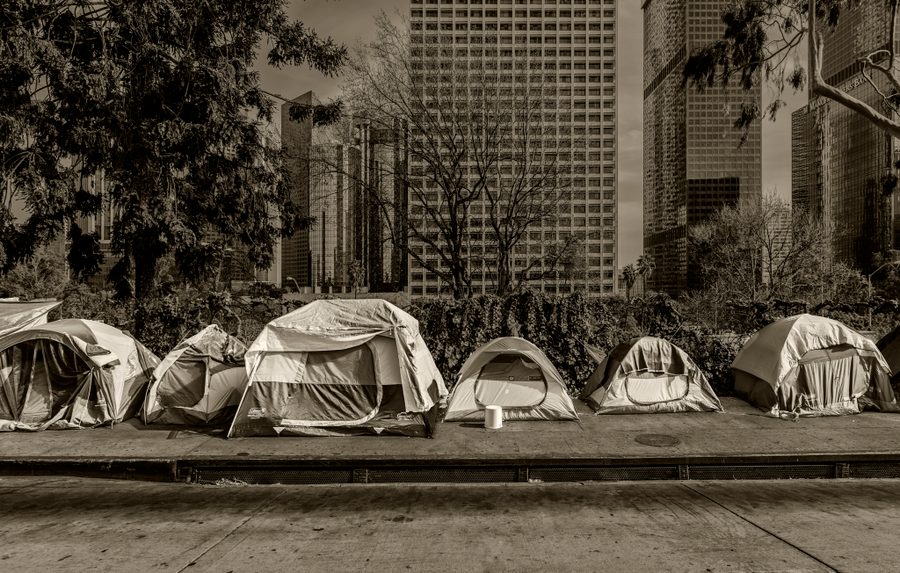We Can Solve Homelessness (If We Want To)
Our economic priorities have created a serious housing crisis and fueled homelessness. Solving the problem simply requires us to change our priorities from profits to people.
Sonali Kolhatkar

California is home to Hollywood and Disneyland, sun and sand, and… nearly one-third of all unhoused people in the entire nation. Compare this to the fact that 12 percent of the nation resides in the Golden State and it becomes clear that there is a serious problem of housing that undercuts the Left Coast’s liberal reputation.
An extensive study of the state’s struggle with homelessness by the Benioff Homelessness and Housing Initiative at the University of California, San Francisco (UCSF) paints a detailed picture of the problem, and it’s not pretty. Homelessness is thriving at the intersections of racism, sexual violence, overpolicing, and more. The report’s authors explain, it “occurs in conjunction with structural conditions that produce and reproduce inequalities.”
Contrary to the popular perception that good weather fuels voluntary homelessness and consists largely of transplants from out of the state, the report points out that 90 percent of the unhoused had been living in California when they lost access to housing. And, three-quarters continue to remain in the same county.
The problem also manifests in systemic racism, with Black and Indigenous people overrepresented among the unhoused compared to their populations. More than a quarter of all unhoused people in California are Black, and yet only 6.5 percent of the state’s overall population is Black.
Homelessness also fuels sexual violence that disproportionately impacts unhoused LGBTQ people and women. More than one-third of transgender and nonbinary people currently experiencing homelessness reported being victims of sexual violence, while 16 percent of cisgender women did so as well.
And, nearly half of all the study’s participants (47 percent) report being harassed by police. Law enforcement routinely subjects California’s unhoused population to violent police raids, dehumanizing searches and seizures of property, forced relocation, and incarceration. The unhoused are disproportionately criminalized by a system that pours a significant amount of tax dollars into policing rather than into affordable housing. Increasingly, cities are simply making it illegal to live outdoors, as if criminalizing homelessness will magically make the math of housing affordability work out.
The UCSF report is neither the first, nor will it be the last one to explore the extent of homelessness in California. And while it makes clear how serious the problem is, the main question remains: how to solve it?
There are several policy solutions put forward including rental assistance in the form of housing vouchers, an exploration of shared housing models, mental health treatment, and even a progressive-sounding monthly income program. But these are merely metaphorical band-aids being applied to a gaping, bleeding wound. None of them address the fundamental reason of why there are more than 171,000 people without housing in California.
Interestingly, one of the UCSF study’s main authors, Dr. Margot Kushel, honed in on the core issue in an interview with the San Francisco Chronicle when she said, “We have got to bring housing costs down, and we’ve got to bring incomes up… We need to solve the fundamental problem — the rent is just too high.”
This is a nationwide problem and California is merely on the front lines.
So, how to bring housing costs down? The federal government sees a shortage of homes as the problem, treating it as an issue of supply and demand: increase the supply and the price will fall. But there is no shortage of housing in the nation. There is a shortage of affordable housing and as long as moneyed interests keep buying up housing, building more won’t be a fix.
Since at least 2008, hedge funds have been buying up single-family homes and rental units in California, throwing a bottomless well of cash at a resource that individuals need for their survival and pushing house prices and rents out of reach for most ordinary people. This too is a nationwide phenomenon, one that was extensively outlined in a 2018 report produced by the Alliance of Californians for Community Empowerment (ACCE), Americans for Financial Reform, and Public Advocates.
That report makes it clear that Wall Street hedge funds see housing as the next frontier in profitable investing. Once these funds buy up homes and apartments to rent out, they cut the labor and material costs associated with maintenance, and routinely raise the rents.
And why wouldn’t they? Their bottom line is profits, not safe, clean, fair, affordable housing. In 2000, the average American renter spent just over 24 percent of their income on housing. Today that percentage has jumped to 30. Hedge fund landlords are likely celebrating their success at getting “consumers” to fork over a larger share of money for their “products.”
The only way to stop hedge funds from taking over the housing market is… [drumroll] to stop hedge funds from buying up homes. To that end, the ACCE report calls on local municipalities and state governments to offer tenants the first right of refusal in purchasing homes, along with appropriate supports, and then offer nonprofit institutions like community land trusts to have the second right of refusal to purchase. It also calls on the federal government to “not incentivize speculation, or act to favor Wall Street ownership of housing assets over other ownership structures.”
The other end of the problem is that incomes are too low. According to Dean Baker at the Center for Economic and Policy Research, the federal minimum wage ought to be $21.50 an hour in order to keep up with the rise in productivity. But it’s not. It’s a horrifyingly low $7.25 an hour. And while a growing number of states are in the process of pushing that wage floor far higher to about $15 an hour, it doesn’t come close to what’s needed. Even the few dozen cities that have forced the minimum wage past their state requirements don’t get to $21.50 an hour.
Yes, individual incomes are rising because of worker demands on employers, but they are not keeping up with inflation. And even though government officials admit that rising wages don’t fuel inflation, the Federal Reserve sees rising wages as the problem, countering them with higher interest rates.
Putting together these pieces of the puzzle, one can only conclude that our economy is designed to keep ordinary Americans living hand to mouth, running on an endless treadmill just to keep from falling into homelessness.
The rent is too damn high — to cite affordable housing activists—and wages are too damn low. That is the nutshell description of an economy that is simply not intended to center human needs.
Passing laws to prevent hedge funds and other large businesses from buying up homes and apartments and raising the minimum wage to at least $21.50 are hardly radical ideas, but they offer course corrections for an economy that is running roughshod over most of us. Rather than tinkering at the edges of the problem and putting forward complex-sounding solutions that don’t actually address the root of the issue, wouldn’t society be better served by redesigning our economy to make homelessness obsolete?
This article was produced via Economy for All, a project of the Independent Media Institute.
Sonali Kolhatkar is the founder, host and executive producer of “Rising Up With Sonali,” a television and radio show that airs on Free Speech TV and Pacifica stations. She is a writing fellow for the Economy for Allproject at the Independent Media Institute.







